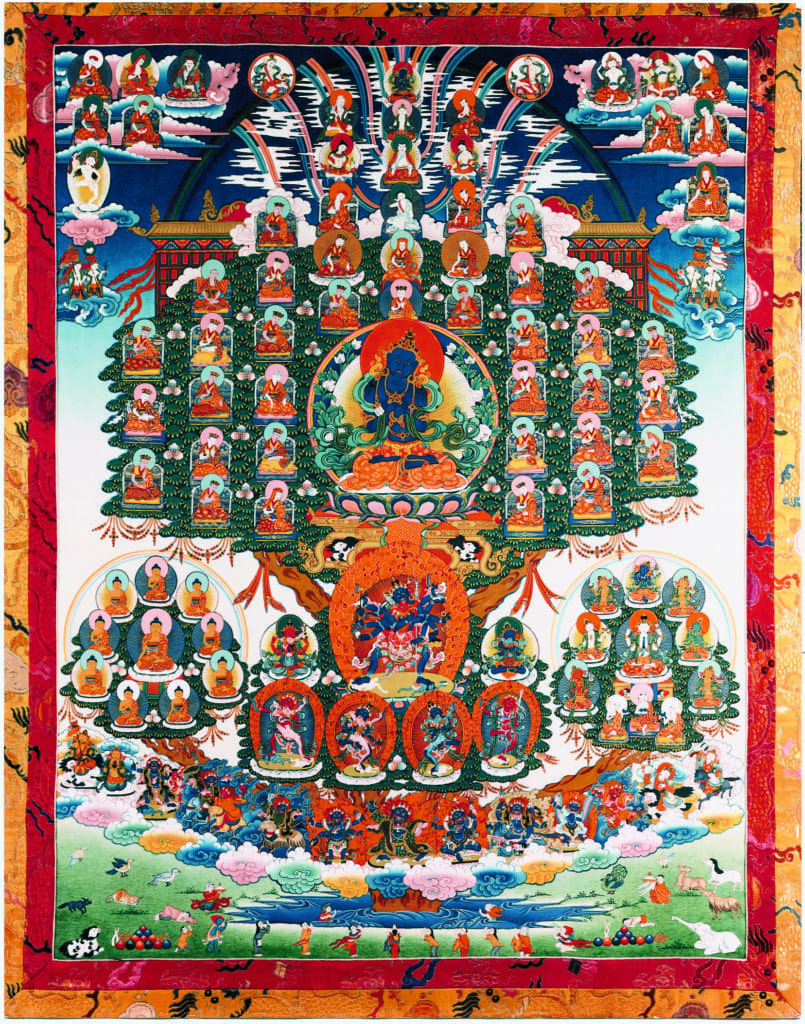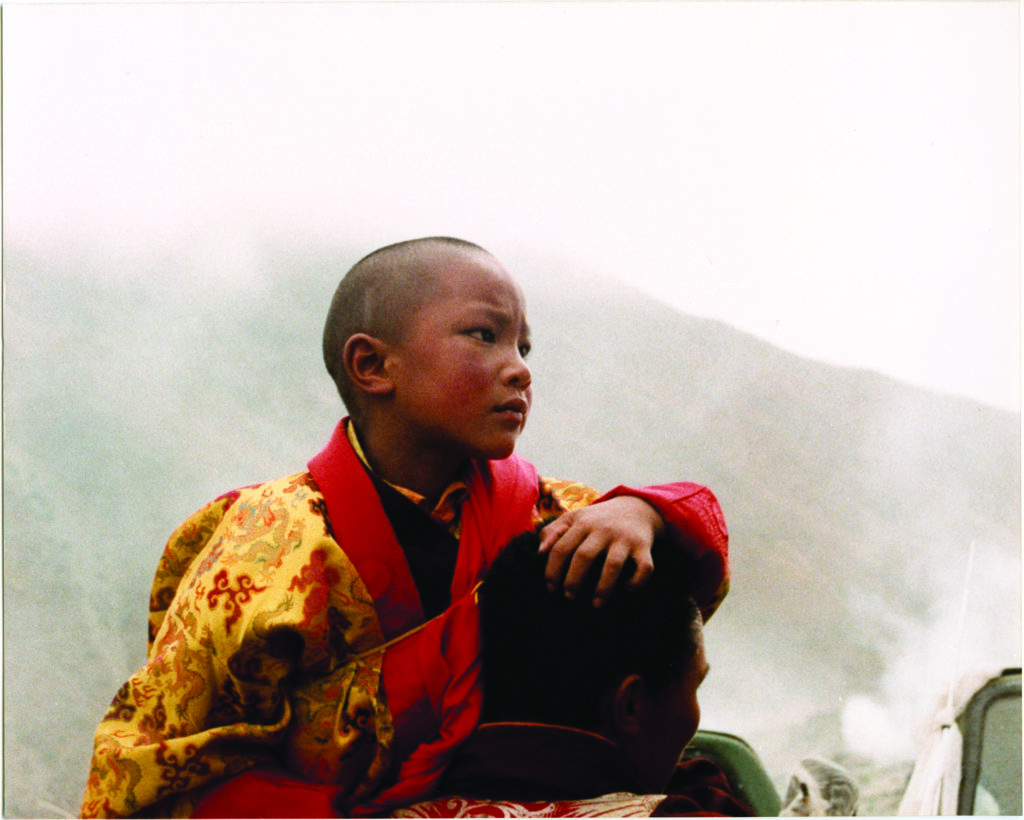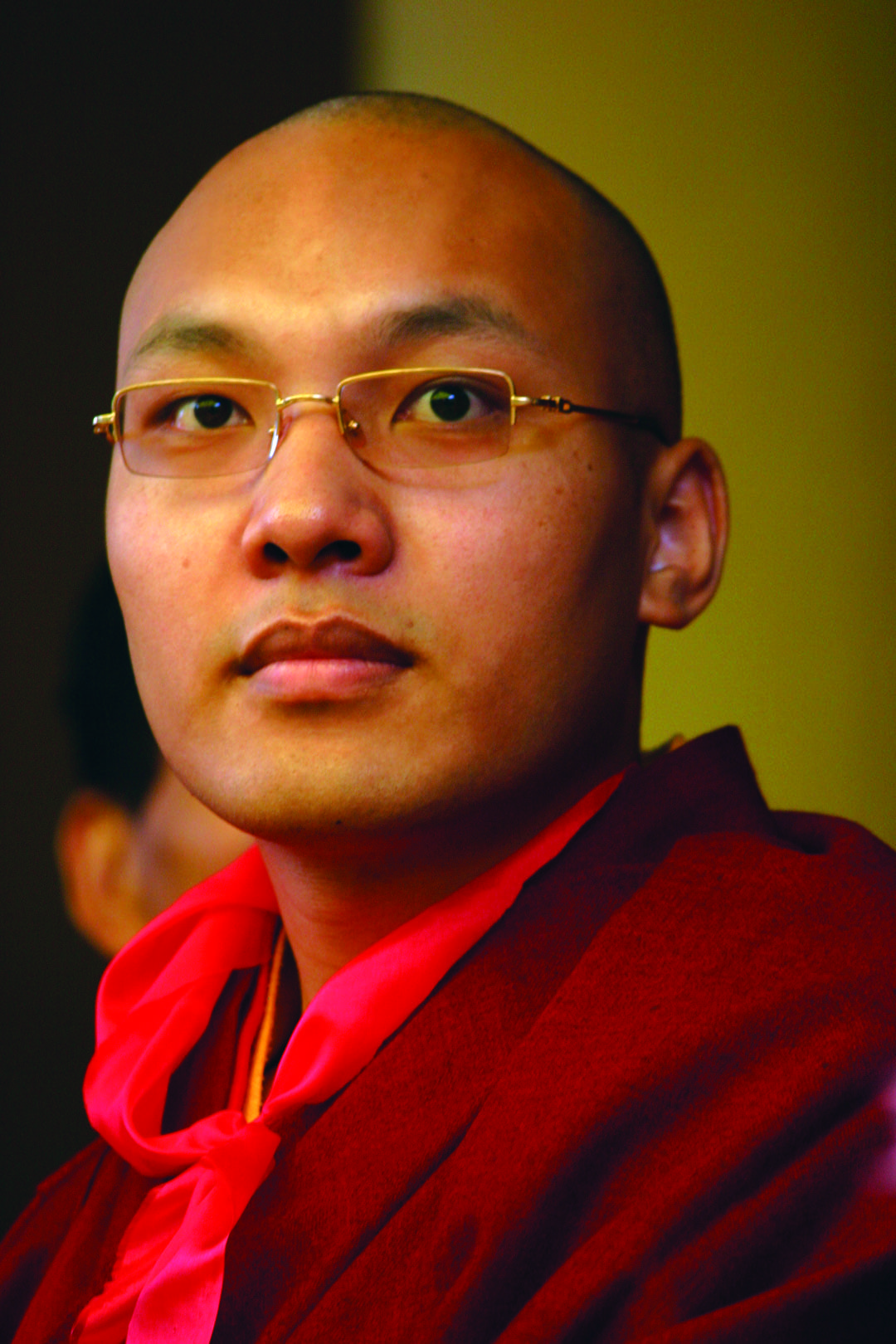This May His Holiness the Seventeenth Gyalwang Karmapa, Ogyen Trinley Dorje, is making his historic first trip to the United States. Unlike the Dalai Lama, another teacher whose position has been inherited through the ancient tulku system of reincarnate lamas, the Seventeenth Karmapa is not yet well known in the West, even in the Buddhist community, although his daring escape from Tibet eight years ago was widely covered in the Western press.
Since the Karmapa is only twenty-two years old and has not yet traveled extensively, his relationships with the wider world are just beginning. Those who are familiar with the line of the Karmapas, and those who met his predecessor, the Sixteenth Karmapa, during his visits to America, feel this visit will be historic and meaningful for Buddhism in the West. They expect the Seventeenth Karmapa, like his predecessors, to be a teacher who makes an impact.
According to Robert Thurman, Jey Tsong Khapa Professor of Indo-Tibetan Buddhist Studies at Columbia University and founder of Tibet House, “The Seventeenth Karmapa will represent Tibet and Buddhism in a really wonderful, twenty-first century way. He will expand the contribution that Tibet makes to the world in a time of conflict, nationalism, racism, and religious fanaticism.”
The Karmapa’s role, Thurman says, is twofold: he is charged with carrying on one of the four major lineages of Tibetan Buddhism, the Kagyu, and, like His Holiness the Dalai Lama, he is also a spokesperson for the message of Buddhism altogether.
Mick Brown, a reporter for The Daily Telegraph in London, is delighted that the Karmapa has finally been able to leave India and travel to the West. Brown sought out the Seventeenth Karmapa in the summer of 2000, not long after his arrival from Tibet in January of that year. A book about the Karmapa and his journey, The Dance of 17 Lives, emerged from the conversations Brown undertook with the then fifteen-year-old Karmapa and a number of Kagyu teachers.
“I was knocked backwards by his presence and his composure,” Brown told me of his first meeting with the Karmapa. “It was arresting and kind of nervous-making, really. He was certainly unlike any fifteen-year-old I’d ever met. Of course, part of that can come from the expectation you have of meeting him and the protocol that surrounds an important figure, but nevertheless he definitely had a gravitas beyond his years.
“On our third or fourth meeting, though, he showed me some of his paintings, which were colorful and playful, not religious depictions of bodhisattvas, and I was charmed by that. He was childlike in that instance, and I was charmed by this one moment when he didn’t seem like someone so much older than his years.”
His Holiness the Sixteenth Karmapa, Rangjung Rigpe Dorje, could be quite playful and childlike, as many discovered when he visited the United States in 1974, 1976, and 1980. He was first hosted by Kagyu teachers who had begun to take students in the West, including Chögyam Trungpa Rinpoche and Kalu Rinpoche, and then by Karma Triyana Dharmachakra, in Woodstock, New York, his North American seat. These visits were whirlwind affairs, with large groups of monks and fellow teachers journeying to Disneyland, the Capitol Building in Washington, Hopi Indian lands, pet stores (the Sixteenth Karmapa was very fond of finches), and untold numbers of venues large and small.
Thousands of people, including Buddhists from a variety of traditions, took part in the renowned Vajra Crown, or Black Crown, ceremonies held in a variety of cities. The Vajra Crown’s shape, color, and ornamentation represent a variety of dharmic principles, and it is said to be modeled after a crown seen in a vision over the first Karmapa’s head. At the moment when the Karmapa places the crown on his head, it is said that the transmission of the Karmapas’ realization is shared by everyone taking part.
These events were glorious, festive, and ordinary. When I took part, I was a young student of the dharma—equal parts impressionable and skeptical—and what struck me about the Karmapa was how he carried himself as an ordinary person, and how he greeted you as if you were his long-lost friend. I could tell that he knew and embodied all the elaborate dharma I had been studying, and yet he was so easygoing, and wore his great understanding so lightly, that I surely could have introduced him to my mother, for whom Buddhism was the pinnacle of all that was exotic and strange.
Michele Martin, a Tibetan translator and Buddhist author, knew the Sixteenth Karmapa well and has been getting to know the Seventeenth since he moved to India. In 2002 she wrote Music in the Sky, a book about his life, art, and teachings. “What’s quite amazing about the Karmapa,” Martin told me, “is his ability to be deeply rooted in a traditional Buddhist world and to nurture those traditions, and at the same time relate to the modern world in a very skillful way. He’s able to be in both worlds at the same time. This is vital, because we need the depth and the wisdom that’s passed along in the lineage, but we also need it to be adapted to a modern context, and he’s uniquely qualified to do that.”
To understand the kind of responsibility the Karmapa holds, it’s helpful to place his role in the context of Buddhism in Tibet. The current Karmapa is regarded as the embodiment of the very first Karmapa, who lived in the twelfth century and traced his practice lineage back to the tenth-century Indian yogi Tilopa. How did we get from there to here?
For thirteen centuries, Buddhism developed, expanded, and flourished in the high elevations and protected valleys of Tibet and the surrounding Himalayan region. Imported from India, the Vajrayana, or tantric, yogic form of Buddhism that took root there seemed to suit the rugged nomadic culture. Tibet became home to thousands of monasteries and mountain retreats. Traveling tent cities carried the dharma across the countryside, and the equivalent of universities of Buddhist studies developed intricate commentarial traditions. The variations in the path were, and are, manifold, owing to differing Indian sources and the crazy-quilt landscape of Tibet, which fostered powerfully independent communities.
Over the centuries in Tibet, Vajrayana Buddhism established many systems to ensure that its teachings and practices would reliably continue from generation to generation. The Vajrayana gives paramount importance to transmission from teacher to student by word of mouth and direct instruction. So each of the many schools and sub-schools passed their teachings on through an intricate hierarchy. In many cases authority was vested in tulkus, reincarnate lamas whose rebirth was chosen with the intent of carrying on a tradition. After the Dalai Lama and the Panchen Lama, the most well-known tulku is the Karmapa.

The Gyalwang (“Victorious”) Karmapa is responsible for ensuring that the teachings and practices of the Kagyu remain intact and that what is practiced today leads to realization as surely as it did for those who practiced it a thousand years ago. According to the history that every Kagyu practitioner knows, the lineage began with the spontaneous insight of the wild Indian yogi Tilopa, who passed his realization on to his principal student, the scholar Naropa, who passed it on to the Tibetan translator and farmer Marpa.
Marpa’s principal student was the cave-dwelling ascetic and Tibetan national hero, Milarepa, whose principal student was Gampopa, a monk and physician who established the first Kagyu monastery. Gampopa had many students and is the source of several lineages, but his most significant student was Tusum Khyenpa, the founder of the Karma Kagyu, whose contemporaries gave him the title Karmapa, meaning “the man of Buddha activity.” He dubbed the lineage he founded “the practicing lineage,” to emphasize that without vigorous application, no amount of learning will bring about results.
Tusum Khyenpa established many monasteries, including Tsurphu, near Lhasa, which was to become the seat of the Karmapas for more than seven hundred years. It was also Tusum Khyenpa who decided that the best way to ensure the continuation of the lineage was to give a letter to his principal student instructing him how to find his future incarnation, who would be installed as head of the lineage after a period of regency. The second Karmapa, Karma Pakshi, became the first formally recognized tulku, creating a system for maintaining continuity of the teachings that became widespread.
The various Tibetan lineages are not isolated from one another. Teachers from different schools study with each other, and students are encouraged to be familiar with teachings from a variety of sources. What lineage supplies is a systematic path and methods of training, rather than an ideological home to reside in. The various Karmapas throughout history were supported in their work by many other teachers within the Kagyu family, as well as a number from other lineages. In that way, they developed a rich textual and liturgical tradition, containing many cross references and quotations from multiple sources.
The most prominent of these great spiritual works expound the teachings of Mahamudra, the “Great Seal,” which is said to be both the pinnacle of the Kagyu path and the thread that runs through it from beginning to end. While explanations of the meaning of the term “Mahamudra” abound, it is said to refer to the fact that since all of reality is buddhanature, it is “sealed” with the mind’s true nature, luminosity-emptiness. The experiential meaning of Mahamudra is beyond words, but Tilopa offered a pithy summation: “Mahamudra mind dwells nowhere.”
Such simplicity is born from extensive training, study, instruction, and practice. It is the Karmapas’ role to ensure that the transmission of the practicing lineage remains fresh and intact, not so much by being a good leader, though this is important too, but mainly by embodying the spirit and realization of Mahamudra’s true meaning. The stories of the many Karmapas—who were variously poets, artists, scholars, musicians, and calligraphers—demonstrate that the Mahamudra realization can manifest in a great variety of guises.
The twentieth century tested the strength of the Karmapa lineage as never before. The Sixteenth Karmapa was born in 1924 and recognized shortly thereafter according to instructions from his predecessor. At the age of eight he was enthroned at Tsurphu, but before long it became clear that political trouble would threaten the way of life that had been sustained in Tibet for a thousand years. As it says in Empowerment, a book created to commemorate the Sixteenth Karmapa’s first visit to the United States, he “had the heavy task of sustaining the meditative legacy of the Kagyu order through the dissolution of the society which supported it for hundreds of years.”
In 1954, the Sixteenth Karmapa accompanied the Dalai Lama to China. The Karmapa was becoming very concerned about Chinese activities in Tibet, and in 1958 he made the bold decision to escape to India through Bhutan, bringing with him a large party of monks as well as many precious ritual objects and texts. In 1962, at the invitation of the royal family of Sikkim, he founded Rumtek Monastery, near Gangtok, as the seat of the Karmapas. He spent much of the rest of his life consolidating the position of the Kagyu lineage on new soil and helping to expand it throughout the world. He returned to the United States in 1981 to be hospitalized in Illinois, where he died.
The Seventeenth Karmapa, Ogyen Trinley Dorje, was born on June 26, 1985, to a nomad family in eastern Tibet. His given name was Apo Gaga. At the age of seven, he was recognized as the reincarnation of the Sixteenth Karmapa. In 1992, the Dalai Lama officially confirmed this recognition, and in an unusual move, the Chinese government issued an official certificate accepting the Karmapa as a reincarnate lama and head of the Kagyu lineage. As has happened in the past, this tulku recognition was not without controversy. Since 1994, another claimant for the title of Seventeenth Karmapa has received some support in the Tibetan Buddhist world and from some Western Kagyu adherents.
From 1992 to 1999, the Karmapa underwent traditional training and education at Tsurphu and also oversaw the rebuilding of the monastery, which had been severely damaged during the early period of Chinese occupation. Despite the apparent support, it became clear over time that the Chinese government would not allow the Karmapa access to the teachers and teachings he would need to fulfill his role as the Karmapa. So he resolved to leave Tibet.

On December 28, 1999, the Karmapa pretended to go into retreat, but instead he dressed in civilian clothes and began a trip by car, foot, horseback, helicopter, train, and taxi. Seven days later he arrived in Dharamasala, India, and was greeted by the Dalai Lama. Yet another Karmapa had emerged into the wider world.
Since that time, the Karmapa has been living at Gyuto monastery, near Dharamsala, where he has continued his training and education, including studies in English, Chinese, and traditional Western subjects. Tibetan teachers put great store in the training system for a tulku. Recognizing a child as an incarnate lama is only to recognize the potential for development and realization believed to reside there. The proof of a tulku’s power and influence comes from his own developing realization, which is aided by the work of many teachers, most of whom have studied with the previous incarnation.
In addition to his studies, the Karmapa has begun to take on many aspects of the Karmapa’s leadership role. He has been interested in reviving traditional forms of monasticism, so he has brought back the practice of monks carrying begging bowls and not eating after noon. He also recently declared that Kagyu monasteries outside of Tibet would change to a vegetarian diet. As well, he has also taken a strong interest in publishing and in seeing that the full range of the liturgical tradition of the Kagyu is practiced, which has made it necessary to reinstate some practices that had fallen into disuse. Meanwhile, the continued existence of another claimant to the title of Karmapa remains the source of legal proceedings in the Indian courts. At stake is the ownership and control of assets of the Kagyu lineage, including Rumtek Monastery in Sikkim and sacred objects brought by the Sixteenth Karmapa from Tibet. However, the overwhelming majority of senior Kagyu teachers and Kagyu practitioners internationally recognize Ogyen Trinley Dorje as the Seventeenth Karmapa.
Since coming to India, the Karmapa has welcomed many visitors from around the world and is offering teachings on a regular basis. Michele Martin, who has had many opportunities to meet with the Karmapa, says that “The Karmapa knows the Western frame of mind very well and understands that the circumstances and time commitments of Westerners differ from what he was familiar with. He also speaks from a personal perspective, which is very common for Westerners, but quite atypical for Tibetans. He directs his answers to the context of the person he’s speaking with. He is also attentive to the nuances between different English words.”
Mick Brown feels the Karmapa is getting ready to fill big shoes. “It seems apparent,” Brown says, “that the Karmapa eventually will have the same kind of leadership role as the Dalai Lama. Whether he will fill it in quite the same way as the Dalai Lama, or have quite the same purpose as the Dalai Lama, remains to be seen. But from my small encounter with him and from what everybody else says, he’s clearly a very charismatic figure and is emerging as an eloquent and wise teacher. That will be projected onto a much wider stage, the world stage. That’s why it’s significant and exciting that he is now finally allowed to travel the world. It’s time for him to come to America.”
Robert Thurman agrees with Brown’s assessment and thinks the Karmapa is well-suited to the task that lies ahead. “Many dharma students in the West will be interested in the Karmapa,” Thurman says. “For one thing, he’s a great lama, but also many people knew his previous incarnation. He had a great impact, and this Karmapa will grow into someone capable of communicating to the larger world, as the Dalai Lama has done. He also has to reach way beyond people who are simply interested in Tibetan Buddhism. The new Karmapa can do that. He strikes me as someone who is inspired by non-sectarianism and dialogue with all sorts of people, not with signing people up to become Buddhists.”
Martin says that the Seventeenth Karmapa also has great concern for young people and the world they will inherit. But the most striking feature, according to Martin, is that he is willing to be blunt. “What’s really quite wonderful,” Martin says, “and what will appeal particularly to younger people is that he’s very honest and he’s very direct. When there are faults, he just points them out. He’s so straightforward that there’s a sense of really being able to trust his word. It’s what the Tibetans call danzig, or speaking the truth. In an age of double talk, cynicism, and spin, he’s just totally the opposite, and I think that will really be a magnet for people.”

